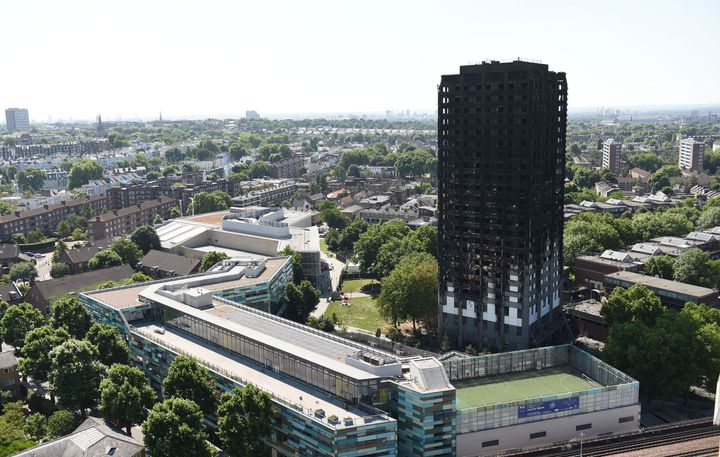Grenfell was riddled with fire risks as a result of the tower’s refurbishment and residents were given damaging advice to “stay put” in their homes as flames wrapped around the 24-storey building on June 14, the first day of evidential hearings into the disaster heard on Monday.
Poorly performing fire doors, questionable decisions taken by the London Fire Brigade and the refurbishment of the tower were all outlined on Monday.
Five expert reports, as well as audio and video recordings from the night of the fire, which left 72 people dead, were released on Monday, with Richard Millett QC making the opening statement to the inquiry.
Here are the key findings from the first day of proceedings:
1. The failure of the ‘stay put’ strategy
Dr Barbara Lane’s report, submitted to the Grenfell Tower Inquiry, found that all residents should have been evacuated much earlier after the approach failed within about 30 minutes.
Dr Lane, a leading fire safety expert, said she was “particularly concerned” by the delay after 2am, when a major incident was declared, until 2.47am before the advice was officially changed to total evacuation.

Millett told the inquiry: “The evidence currently suggests that around 187 occupants, about 64%, had evacuated the tower by the time the ‘stay put’ advice was formally abandoned at 2.47am.
“The evidence also suggests that the rate of evacuation substantially slowed from 1.38am. Before that time 144 people had left the building, and after the ‘stay put’ guidance was changed an hour later, only 36 people managed to escape the tower.
“It may well be that the withdrawal of the formal ‘stay put’ guidance at that stage was just that – mere formality in light of the number of occupants that had escaped safely before that time.
“On the other hand, it may be that the formal maintenance of that advice until 2.47am made all the difference between life and death.”
In a report compiled for the inquiry, Dr Lane found that the stairwell – Grenfell Tower’s only escape route – was “smoke-logged from 1.40am onwards”. The “stay put” advice was eventually abandoned at 2.47am.
Dr Lane, a fire safety engineer, recommended that blocks of flats should have an automatic or manual means of raising an alarm or providing voice alarm announcements, as currently it is not possible to easily communicate changes in advice.
On the night of June 14, when the fire broke out, Lane said it was “not clear at this stage how the ‘all out’ message was communicated to residents who were still in the Tower”.
She added that there needs to be “serious and urgent” consideration to changing the current approach in buildings enveloped in similar material to Grenfell.
A further report by fellow fire expert Colin Todd, also released on Monday, noted: “As was clearly demonstrated in the tragic circumstances of the Lakanal House fire in 2009, it is absolutely vital that the concept of ‘stay put’ is properly explained to residents (particularly as, for some residents, it may be non-intuitive and, of course, contrasts with the fire procedures they will experience in their place of work). In particular, it is important that residents understand that the ‘stay put’ strategy does not apply if they consider themselves threatened by the fire (e.g. as the result of entry of smoke or fire to their flats).”
2. Firefighters’ actions
Dr Lane’s report found that firefighters may have contributed to the spread of fire and smoke into the stairwell by leaving doors ajar as they fought the blaze.
She wrote: “I have identified the fact that the firefighting operations in response to the multi-storey fire may have contributed to the failure of the stair fire doors to prevent fire and smoke spread.
“Current evidence indicates some of the stair doors were ajar as firefighting hoses were running from the stair into the lobby. However, I currently do not know the number of doors involved, nor which specific doors, nor for how long this opening may have occurred. I cannot yet conclude whether this made a significant contribution.”

3. The times at which residents escaped
Prior to 1.20am, 34 residents left the building, Dr Lane’s report outlines, with occupants escaping from all floors up to level 13.
The largest number of evacuations took place between 1.19am and 1.38am, with 110 people leaving. At this time the stairs were free of smoke, Dr Lane says.
However, by 1.40am “significant” smoke was gathering in the stairwell. At this time there were still 151 residents in the building.
From this point on, the rate of people evacuating Grenfell Tower slowed significantly.
4. Sub-standard fire doors
Dr Lane’s report found that poorly performing fire doors “contributed significantly to the spread of smoke and fire to the lobbies” on the night of the blaze.
This failure “would have materially affected the ability or willingness of occupants to escape independently through this space to the stair”, the report found.
It would have also hindered the ability of firefighters to rescue many people on the tower’s upper floors.
In 2011, the Tenant Management Organisation (TMO), which ran the building, replaced 106 flat entrance fire doors. None of the doors on any of the 120 flats – including the 14 not replaced – were compliant with the fire test evidence relied upon at the time of installation, Dr Lane found.
These shortcomings would have had a number of consequences, including failure to prevent the spread of smoke and flame by leakage through gaps between the door leaf and door frame.
Another failure of an “unknown number of doors” to self-close after an occupant escaped would have allowed “immediate” spread of fire and smoke.
The lobbies could therefore not be used as a “safe air environment” by the fire service bridgehead, forcing it to remain below level 4 until 7.30am.
“This greatly reduced the time available using breathing apparatus, and so the time available for rescue on the upper floors, and particularly above Level 15.”
5. The cladding
Images were shown to the inquiry showing Grenfell Tower before and after the refurbishment, which was completed in 2016.
Prior to the refurbishment, the tower was predominantly a concrete structure, with concrete floors, panels and columns, the hearing was told.
Dr Lane’s report said the cladding did not comply with recommended fire performance, meanwhile Professor Luke Bisby, an expert in fire and structures at the University of Edinburgh, said that it is likely that the polyethylene material in the cladding was the main cause of the spread of the fire.
Millett told the inquiry: “What is abundantly clear is that the building envelope created an intolerable fire hazard.
“There was a catastrophic failure of the rain screen cladding in terms of its ability to resist the fire spread across the walls of the building.
“All the relevant experts are clear that the consequence was a fire that affected multiple storeys and multiple compartments with many post-flashover fires occurring internally on multiple compartments and on multiple storeys.”
Dr Lane found no evidence that some of the key bodies involved in the tower’s refurbishment understood how the new cladding system would behave in a fire.
“I have found no evidence that the (TMO) risk assessment recorded the fire performance of the rainscreen cladding system, nor have I found evidence that the LFB risk assessment recorded the fire performance of the rainscreen cladding,” Dr Lane’s report says.
6. Questions for the London Fire Brigade (LFB)
Millett told the hearing that the inquiry has eight questions for the LFB surrounding the events of June 14.
These are:
1. What was the LFB policy, if any, for assessing the materials and construction of a high-rise residential block?
2. Was that policy applied at Grenfell Tower?
3. What, if any, was the policy in case compartments in high rise blocks failed?
4. When exactly did it become obvious to the incident commanders on the ground at Grenfell Tower that that compartmentation had failed?
5. What, if any, change to their strategy did they put in place thereafter? And how?
6. Why was the formal ‘stay put’ policy maintained until 2.47am and not revoked earlier?
7. What difference that revocation made given the volumes of evacuation before that time?
8. How did the change in formal strategy get communication to residents?

7. Origins of the fire
The fire began in flat 16, located on the fourth floor of the tower but in a departure from information given at previous Scotland Yard briefings, one expert report for the Grenfell Tower inquiry said there was “insufficient evidence” that the fire started by a fridge-freezer.
Professor Bisby wrote: “Some evidence exists to support a hypothesis that the fire started in the south-east side of the kitchen and in the general area of the Hotpoint FF175P fridge-freezer, however, there is currently insufficient evidence, even based on a balance of probabilities, in my opinion, to support the hypothesis that the fire originated in the fridge-freezer, and to exclude all other potential sources of ignition.
“With regard to other possible sources of ignition, I have not seen sufficiently convincing evidence to confidently identify the origin of the initial fire.”
Forensic scientist Professor Niamh Nic Daeid said it was possible to say that the area of origin of the fire was in the south-east corner of the kitchen and that it is probable that it was “in or around the area of the tall fridge-freezer located along the south wall of the kitchen”.
Daeid adds: “There is insufficient information and analysis undertaken at this time to be able to determine the cause of the fire that occurred at Grenfell Tower on June 14 2017. As a consequence, the cause of the fire remains undetermined at this point.”
